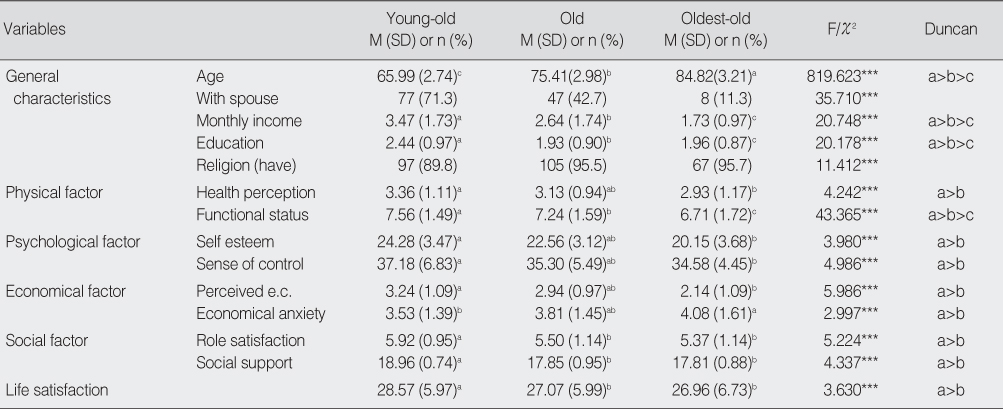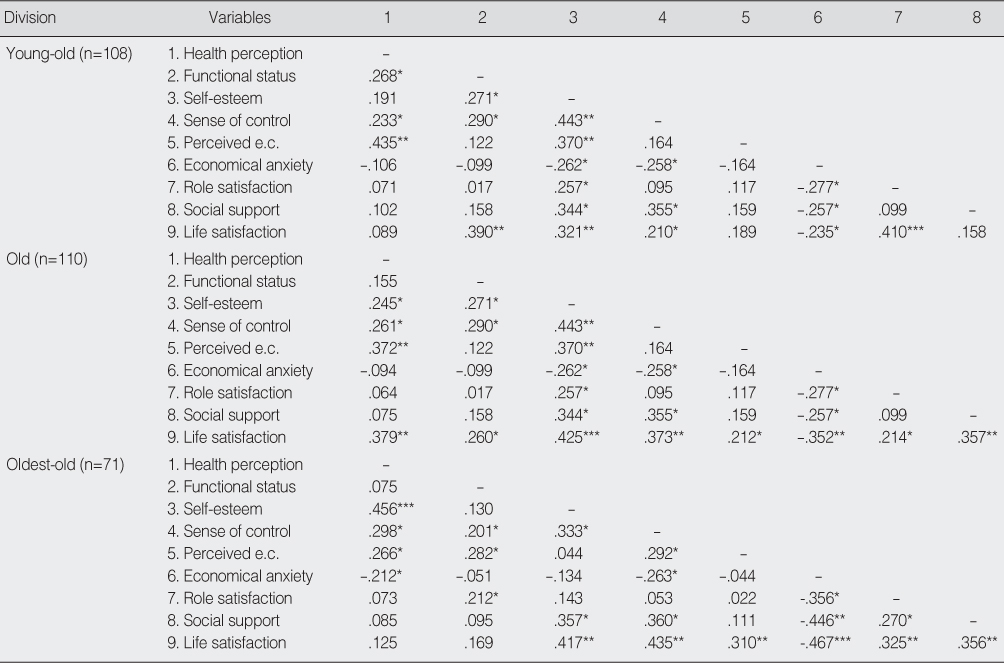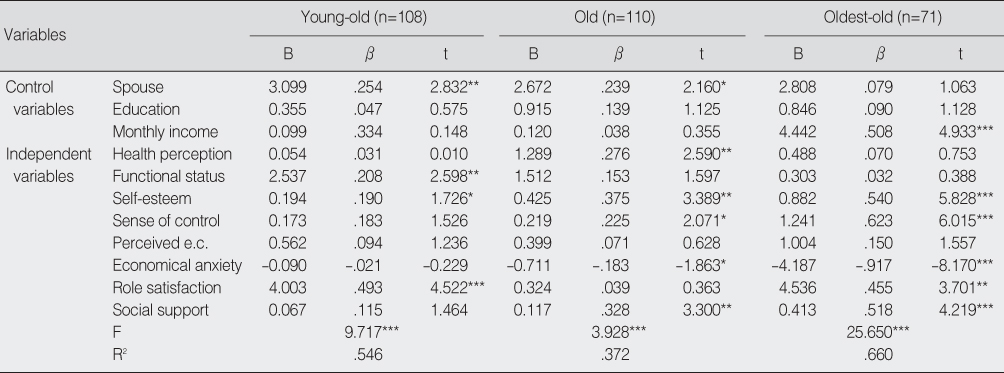Articles
- Page Path
- HOME > J Korean Acad Nurs > Volume 39(1); 2009 > Article
-
Original Article
- Factors related to Life Satisfaction in Young-Old, Old, and Oldest-Old Women
- Kae-Hwa Jo, Hyun Ji Lee
-
Journal of Korean Academy of Nursing 2009;39(1):21-32.
DOI: https://doi.org/10.4040/jkan.2009.39.1.21
Published online: February 28, 2009
1Associate Professor, Department of Nursing, Catholic University of Daegu, Korea.
2Assistant Professor, Department of Social Welfare, Catholic University of Daegu, Daegu, Korea.
- Address reprint requests to: Jo, Kae Hwa. Department of Nursing, Catholic University of Daegu, 3056-6 Daemyeong 4-dong, Nam-gu, Daegu 705-718, Korea. Tel: 82-53-650-4825, Fax: 82-53-621-4106, jokw@cu.ac.kr
Copyright © 2009 Korean Society of Nursing Science
Abstract
-
Purpose
- The purpose of this study was to investigate the level of life satisfaction and the significant factors which impact on life satisfaction of young-old (60-69 yr), old (70-79 yr), and oldest-old (80 yr or above) women.
-
Methods
- The participants for this study were 289 elderly Korean women living in the city of Daegu and Kyongpook province. The data were collected using structured questionnaires. ANOVA, Chi-square, and multiple regression with the SPSS program were used to analyze the data.
-
Results
- There were statistically significant differences among young-old, old, and oldest-old women regarding the existence of spouse, income, educational status, and religions. The model including variables related to physical, psychological, financial, and social aspects of life, explained variance of life satisfaction of elderly women differently, such as 55% of young-old, 37% of old, and 66% of oldest-old. Finally, self-esteem was the only predictor in explaining the level of life satisfaction among old women regardless age.
-
Conclusion
- Based on the findings of the study, implications for practical services for elderly women and recommendations of further study are provided. Nursing interventions should be developed to improve life satisfaction of elderly women according to age differences.
- 1. Balts M, Balts P. The psychology of control and aging. 1986;Hillsdale, NJ, Lawrence Erlbaum.
- 2. Bowling A, Banister D, Sutton S, Evans O, Windsor J. A multidimensional model of the quality of life in older age. Aging & Mental Health. 2002;6:355–371.Article
- 3. Bowling A, Windsor J. Towards the good life. A population survey of dimensions of quality of life. Journal of Happiness Studies. 2001;2:55–81.
- 4. Cha SH, Han KH, Lee JH. Relationship between self-rated health and physical, mental, social health: Differences among three aged group. Journal of the Korean Gerontological Society. 2002;22:173–190.
- 5. Chung HJ, Kim TH, Lee DS. Related variables of life satisfaction of elderly women living alone in Chonbuk-do Province. Journal of the Korean Gerontological Society. 2000;20:49–70.
- 6. Chung SD. A comparative study on the successful aging for Korean elderly women and elderly men. Journal of the Korean Gerontological Society. 2007;27:829–845.
- 7. Clipp EC. In: Quality of life. 2002;New York, NY, Springer Publishing Co..
- 8. Diener E, Emmons RA, Larsen RJ, Griffin S. The satisfaction with the life scale. Journal of Personality Assessment. 1985;49:71–75.ArticlePubMed
- 9. Diener E, Suh EM, Lucas RE, Smith H. Subjective well-being three decades of progress. Psychological Bulletin. 1999;125:276–302.Article
- 10. Grundy E, Bowling A. Enhancing the quality of extended life years: Identification of the oldest old with a very good and very poor quality of life. Aging % Mental Health. 1999;3:199–212.Article
- 11. Hillerås P, Jorm AF, Herliltz A, Winbald B. Life satisfaction among the very old: A survey on a cognitively intact sample aged 90 years or above. International Journal of Aging and Human Development. 2001;52:71–90.ArticlePubMedPDF
- 12. Jeon MY, Choe MA, Chae YR. Effect of Korean traditional dance movement training on balance, gait and leg strength in home bound elderly women. Journal of Korean Academy of Nursing. 2000;30:647–658.ArticlePDF
- 13. Kim ML. The study of comparing the factors of affecting on the quality of life for young-old women and old-old women. Korean Journal of Social Welfare. 2006;58:197–222.
- 14. Kim MS, Park MJ. The impact of religion on the quality of life of the elderly. Journal of the Korean Gerontological Society. 2000;20:29–47.
- 15. Lawton MP, Brody EM. Assessment of older people: Self-maintaining and instrumental activities of daily living. The Gerontologist. 1969;9:179–186.ArticlePubMed
- 16. Lee IJ. A study on the difference between the younger old and the older old: Comparison of the effects of stressful life events and social support on their health. Journal of the Korean Gerontological Society. 1999;19:35–50.
- 17. Lee IS, Kim HS. Sexual life and life satisfaction of rural elderly. Journal of Korean Society of Public Health Nursing. 2007;21:158–170.
- 18. Lee SM, Lee EO. Nursing research. 2005;Seoul, Korea National Open University Press.
- 19. Park HS, Lee KJ. A study on the health behaviors, physical function, and life satisfaction for elderly women. Korean Journal of Women Health Nursing. 2007;13:115–122.ArticlePDF
- 20. Park JS. The effects of an elderly health promotion program on health promotion lifestyles, health status and quality of life in the elderly. Journal of Korean Academy of Nursing. 2004;34:1194–1204.ArticlePubMedPDF
- 21. Procidano ME, Heller K. Measures of perceived social support from friends and from family: Three validation studies. American Journal of Community Psychology. 1983;11:1–24.ArticlePubMedPDF
- 22. Ro SO. A study on the physical, mental, and social factors influencing the health status of aged women in Korea. Korean Journal of Women Health Nursing. 1996;2:47–58.ArticlePDF
- 23. Rogers RG. The effects of family composition, health, and social support linkages on mortality. Journal of Health and Social Behavior. 1996;37:326–338.ArticlePubMed
- 24. Rosenberg M. Conceiving the self. 1979;New York, NY, Basic Books.
- 25. Schumm WR, Hall J. Characteristics of the Kansas Parental Satisfaction Scale among two samples of married parents. Psychological Reports. 1985;57:163–169.ArticlePDF
- 26. Shin JS, An HG, Kim HM, Yoo YJ, Kim KH, Chong IK, et al. Pain of elderly women with osteoarthritis. Journal of Korean Academy of Nursing. 2001;31:180–193.ArticlePDF
- 27. Smith J, Borchelt M, Maier H, Jopp D. Health and well-being in the young old and oldest old. Journal of Social Issues. 2002;58:715–732.Article
- 28. Sung KW. Comparison of ADL and satisfaction state of the elderly in institution and home. Journal of the Korean Gerontological Society. 1999;19:105–117.
- 29. Wallhagen M. Perceived control and adaptation in elderly caregivers. 1990;Seattle, USA, University of Washington. Unpublished doctoral dissertation.
REFERENCES

*p<.05; **p<.01; ***p<.001.
Monthly income (thousand): 1=less than 300; 2=300-490; 3=500-990; 4=1,000-1,490; 5=1,500-1,990; 6=2,000-2,490; 7=more than 2,500.
Education: 1=none; 2=elementary school; 3=middle school; 4=high school; 5=college; 6=graduate school.
Perceived e.c.=perceived economic condition.

Figure & Data
REFERENCES
Citations

- Exploring influential factors in the self-assessment of life satisfaction among Chinese elderly: a structural equation modeling analysis
Jun Yan, Suzhen Wang, Chang Liu, Yuanan Lu
Frontiers in Psychiatry.2024;[Epub] CrossRef - Analysis of factors influencing health literacy of older adults by applying the Anderson model
Eungyeong Kim
Educational Gerontology.2024; 50(2): 140. CrossRef - Understanding changes in mental health symptoms from young-old to old-old adults by sex using multiple-group latent transition analysis
Se Hee Min, Maxim Topaz, Chiyoung Lee, Rebecca Schnall
GeroScience.2023; 45(3): 1791. CrossRef - Evaluation of Sex and Age Factors Contributing to the Diagnosis of Oral Frailty in Community-Dwelling Older Adults
Eun-Ha Jung, Sun-Young Han
Journal of Dental Hygiene Science.2023; 23(4): 378. CrossRef - Social networking sites use and life satisfaction. A quantitative study on older people living in Europe
Alessandra Gaia, Emanuela Sala, Gabriele Cerati
European Societies.2021; 23(1): 98. CrossRef - Development and application of a self-transcendence enhancement program for the well-being of elderly women living alone in Korea
Sun-Mi Kim, Sukhee Ahn
Korean Journal of Women Health Nursing.2021; 27(2): 128. CrossRef - Relationship of health, sociodemographic, and economic factors and life satisfaction in young-old and old-old elderly: a cross-sectional analysis of data from the Korean Longitudinal Study of Aging
Jin-Won Noh, Kyoung-Beom Kim, Ju Hyun Lee, Min Hee Kim, Young Dae Kwon
Journal of Physical Therapy Science.2017; 29(9): 1483. CrossRef - Effects of subjective oral health condition and oral health behavior on happiness in the elderly people
Chung-Soon Park, So-Young Park
Journal of Korean society of Dental Hygiene.2015; 15(3): 443. CrossRef - Factors Affecting Activities of Daily Living, Depression and Life Satisfaction among Aged Women
Journal of East-West Nursing Research.2015; 21(2): 119. CrossRef - A Study on the Experiences of Total Knee Replacement in Elderly Women
Hyun Ok Lee, Soon Hee Lee
Journal of muscle and joint health.2014; 21(3): 206. CrossRef - Factors Influencing the Health-Related Quality of Life by Age among Vulnerable Elderly Women
Yun-Hee Kim
Journal of the Korea Academia-Industrial cooperation Society.2013; 14(3): 1342. CrossRef - Poor health in the Korean older population: Age effect or adverse socioeconomic position
Eun-Ja Park, Sung-il Cho, Soong-Nang Jang
Archives of Gerontology and Geriatrics.2012; 55(3): 599. CrossRef - A study on the model of homebound senior's meal satisfaction related to the quality of life
Sun-Mee Lee, Nami Joo
Nutrition Research and Practice.2012; 6(4): 357. CrossRef - Factors Influencing Perceived Health Status and Life Satisfaction in Rural Residents
Yun-Jung Oh, Yun-Hee Kwon
Journal of agricultural medicine and community health.2012; 37(3): 145. CrossRef - Effect of Family Cohesion, Subjective Happiness and other Factors on Death Anxiety in Korean Elders
Kae Hwa Jo, Byung Sook Song
Journal of Korean Academy of Nursing.2012; 42(5): 680. CrossRef - Effects of Music Therapy and Rhythmic Exercise on Quality of Life, Blood Pressure and Upper Extremity Muscle Strength in Institution-Dwelling Elderly Women
Eun Young Jeon, Sook Young Kim, Hyun Suk Yoo
Journal of Korean Academy of Nursing.2009; 39(6): 829. CrossRef
General Characteristics of Subjects (N=289)
The Level of Life Satisfaction and related Variables according to Age Difference among Subjects (N=289)
*p<.05; **p<.01; ***p<.001.
Monthly income (thousand): 1=less than 300; 2=300-490; 3=500-990; 4=1,000-1,490; 5=1,500-1,990; 6=2,000-2,490; 7=more than 2,500.
Education: 1=none; 2=elementary school; 3=middle school; 4=high school; 5=college; 6=graduate school.
Perceived e.c.=perceived economic condition.
Correlation among Predictable Variables of Subjects according to Age Difference among Subjects
*p<.05; **p<.01; ***p<.001.
Perceived e.c.=perceived economic condition.
Comparison of Variables affecting Life Satisfaction of Subjects according to Age Difference (N=289)
*p<.05; **p<.01;***p<.001.
Perceived e.c.=perceived economic condition; Dummy variables: Spouse (0=no, 1=yes), Education (0=none, 1=elementary, middle, high school, college, and graduate school), Monthly income (0=under 990,000won, 1=over 1,000,000 won).
*p<.05; **p<.01; ***p<.001. Monthly income (thousand): 1=less than 300; 2=300-490; 3=500-990; 4=1,000-1,490; 5=1,500-1,990; 6=2,000-2,490; 7=more than 2,500. Education: 1=none; 2=elementary school; 3=middle school; 4=high school; 5=college; 6=graduate school. Perceived e.c.=perceived economic condition.
*p<.05; **p<.01; ***p<.001. Perceived e.c.=perceived economic condition.
*p<.05; **p<.01;***p<.001. Perceived e.c.=perceived economic condition; Dummy variables: Spouse (0=no, 1=yes), Education (0=none, 1=elementary, middle, high school, college, and graduate school), Monthly income (0=under 990,000won, 1=over 1,000,000 won).
 KSNS
KSNS
 E-SUBMISSION
E-SUBMISSION


 Cite
Cite

